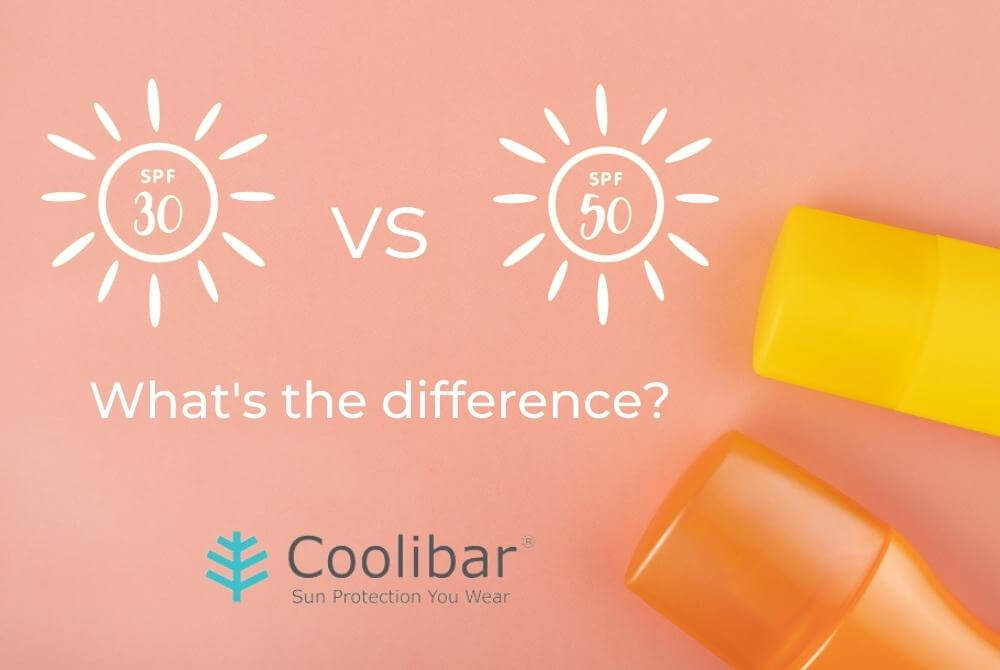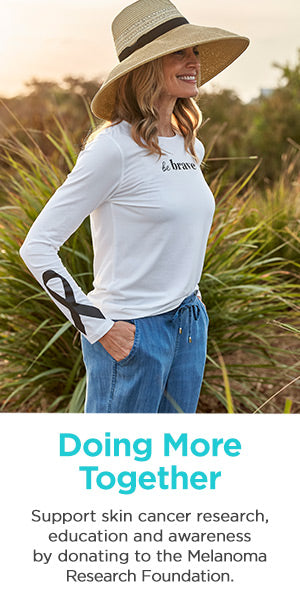SPF 30 vs 50: Which One Is Better For Your Skin?

At Coolibar, we know that the amount of sun protection options on the market can be overwhelming and leave you with a lot of questions like if SPF 30 vs. 50 is better for your skin.
Whether you love spending all your free time outside at the beach or you just venture out for the occasional picnic or hike, sun protection is essential. UVA and UVB sun rays can damage your skin, causing sunburns and wrinkles, and increasing your risk of cancer. That’s why understanding the difference between SPF 30 and 50 is necessary to properly protect yourself from damaging sun exposure.
Learn more about how to safely enjoy your time outdoors with our 10 tips for sun protection. It covers how to apply sunscreen correctly and alternative sun protection options to ensure you and your loved ones are always shielded from the sun’s damaging rays.
What is SPF?
SPF stands for sun protection factor. The SPF rating number tells us how much of the sun’s harmful rays will reach our skin while using the sunscreen according to the directions. The higher the SPF rating, the more UV sun rays are blocked. So, the most straightforward answer to whether there is a difference between SPF 30 and 50 is yes!
But what are UV rays exactly? UV stands for ultraviolet. UV rays are invisible beams of light from the sun that can damage our skin. There are two types of UV rays: UVA and UVB.
UVA rays from the sun do not cause sunburns, but they can cause wrinkling and other skin-aging effects. While some sunscreens protect against UVA rays, the SPF rating does not measure this.
UVB rays are those pesky ones that burn our skin and can lead to cancer. All SPF sunscreens protect against UVB rays, but check your sunscreen to make sure it says “broad spectrum.” This means it protects against the aging effects of UVA rays as well.
Remember that UV rays can damage your skin even on cloudy days, so no matter what SPF rating you choose, make sure to lather up any time you are going to head outside! Also, according to sunscreen expert Kirk Minster, the specific ingredients in your sunscreen matter, so make sure to do your research when choosing the best sunscreen for your skin.
What's the Difference Between SPF 30 and SPF 50?
In the debate between SPF 50 vs. 30, it's vital to understand what these ratings mean. Since we know that higher SPF ratings indicate more protection, SPF 50 protection is going to be stronger than SPF 30. But let's dive more into each of these ratings.
SPF 30
So what is SPF 30, and why is SPF 30 good? SPF 30 sunscreen only allows 1/30 of the sun’s UVB rays to penetrate your skin. That means it blocks about 96.7% of those harmful rays. To ensure this level of protection, make sure to follow all directions on the sunscreen label, including reapplying at least every two hours.
Recommended protection: SPF 30 sunscreen meets the recommended SPF rating from the Skin Cancer Foundation. They recommend SPF 15 for everyday use and SPF 30 for those days where you are spending hours outside.
Reduced risk of cancer: Because UVB rays are the ones responsible for causing skin cancer, all SPF 30 sunscreens help protect you from this risk.
Everyday protection: UVB rays can even penetrate through windows, so SPF 30 can provide everyday protection while driving or sitting at home.
Who should wear it: Anyone who is outside for longer than 20 minutes a day, even on cloudy days, can benefit from wearing SPF 30 sunscreen.
SPF 50
SPF 50 sunscreen only allows 1/50 of the sun’s UVB rays through, blocking 98% of them. Answering the question of is SPF 30 or 50 better is really a personal decision. If you are still getting burned while using SPF 30 sunscreen according to the directions, then consider switching to a different SPF sunscreen with a higher rating.
More protection: SPF 50 blocks about 1.3% more harmful UVB rays than SPF 30.
Longer protection: SPF 50 sunscreens can protect your skin for longer, which means you have to reapply less often. Many SPF 50 sunscreens recommend reapplying every 150 minutes rather than the recommended 120 minutes for SPF 30.
Protection at high elevation: The sun’s rays are stronger at higher elevations, so if you are going skiing or hiking in the mountains, consider SPF 50 or higher.
Who should wear it: Anyone with an increased risk of skin cancer, has prolonged sun exposure, or is outdoors at high elevations may benefit from SPF 50 sunscreen.
[gallery columns="1" size="full" ids="eyJ1cmwiOiJodHRwOlwvXC9jb29saWJhci5sb2NhbFwvd3AtY29udGVudFwvdXBsb2Fkc1wvMjAyMlwvMDVcLzE4X1RSX0xJRl9TTTEyMl8yX01lbl9UcmF2ZWxfVG91cl8wNzAxX1IxLXNjYWxlZC5qcGciLCJ0aXRsZSI6IjE4X1RSX0xJRl9TTTEyMl8yX01lbl9UcmF2ZWxfVG91cl8wNzAxX1IxIiwiY2FwdGlvbiI6IiIsImFsdCI6IiIsImRlc2NyaXB0aW9uIjoiIn0="]
UPF is Also Important for Sun Protection
Now that the critical question, "What is the difference between SPF 30 and 50?" is answered, let's look at another type of sun protection: UPF clothing. UPF stands for ultraviolet protection factor. It's similar to SPF ratings in that it measures how much of the sun's UV rays can penetrate through the clothing's fabric to your skin. A shirt with a UPF 50 rating will only allow 1/50 of UV rays through.
The biggest difference between SPF and UPF is that UPF ratings measure both UVA and UVB rays while SPF ratings only measure UVB rays. This means you are potentially getting more sun protection from UPF clothing than you are from sunscreen. Even with broad-spectrum sunscreen, you may not know exactly how much UVA protection you are getting. Furthermore, sunscreens often contain harmful chemicals, while UPF clothing protects your skin without any dangerous additives.
Learn more about the benefits of UPF clothing versus sunscreen on our Respect the Sun blog.
Discover UPF Sun Protection Clothes and Accessories From Our Team at Coolibar
Sun protection is no longer simply a question of SPF 30 vs. 50. There are broad-spectrum sunscreens that protect against UVA and UVB rays, plus there are more quality UPF clothing on the market than ever before. We offer a variety of clothing with UPF sun protection, including wide-brimmed hats, sun sleeves, and breathable gloves. We’ve got you covered no matter how you like to spend your time in the sun, whether it be lounging at the beach or summiting a mountain!
About Coolibar
For more than 20 years, Coolibar (koo-luh-bar) has stopped at nothing to develop the most technical and elegant sun protective clothing, hats and accessories. The world leader in UPF 50+ fabric technology.


